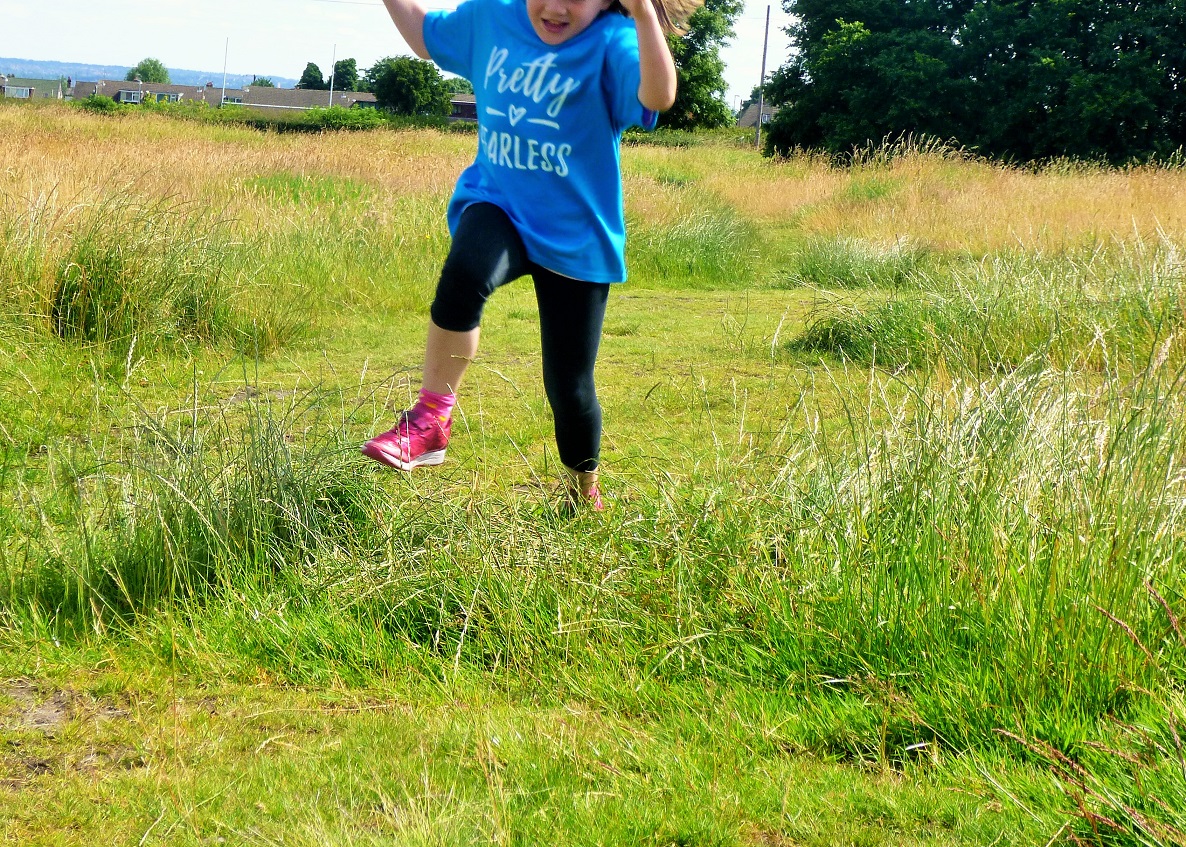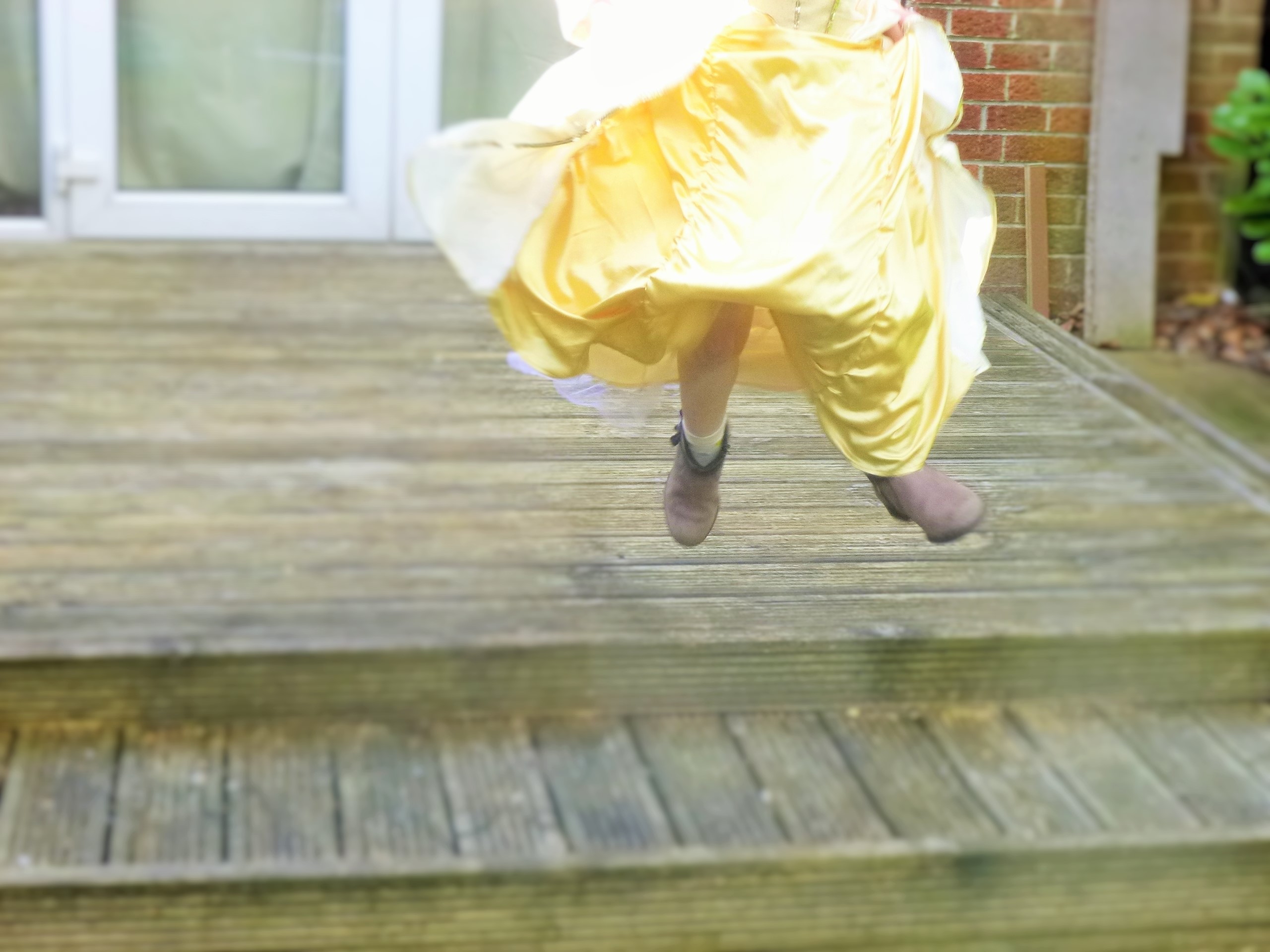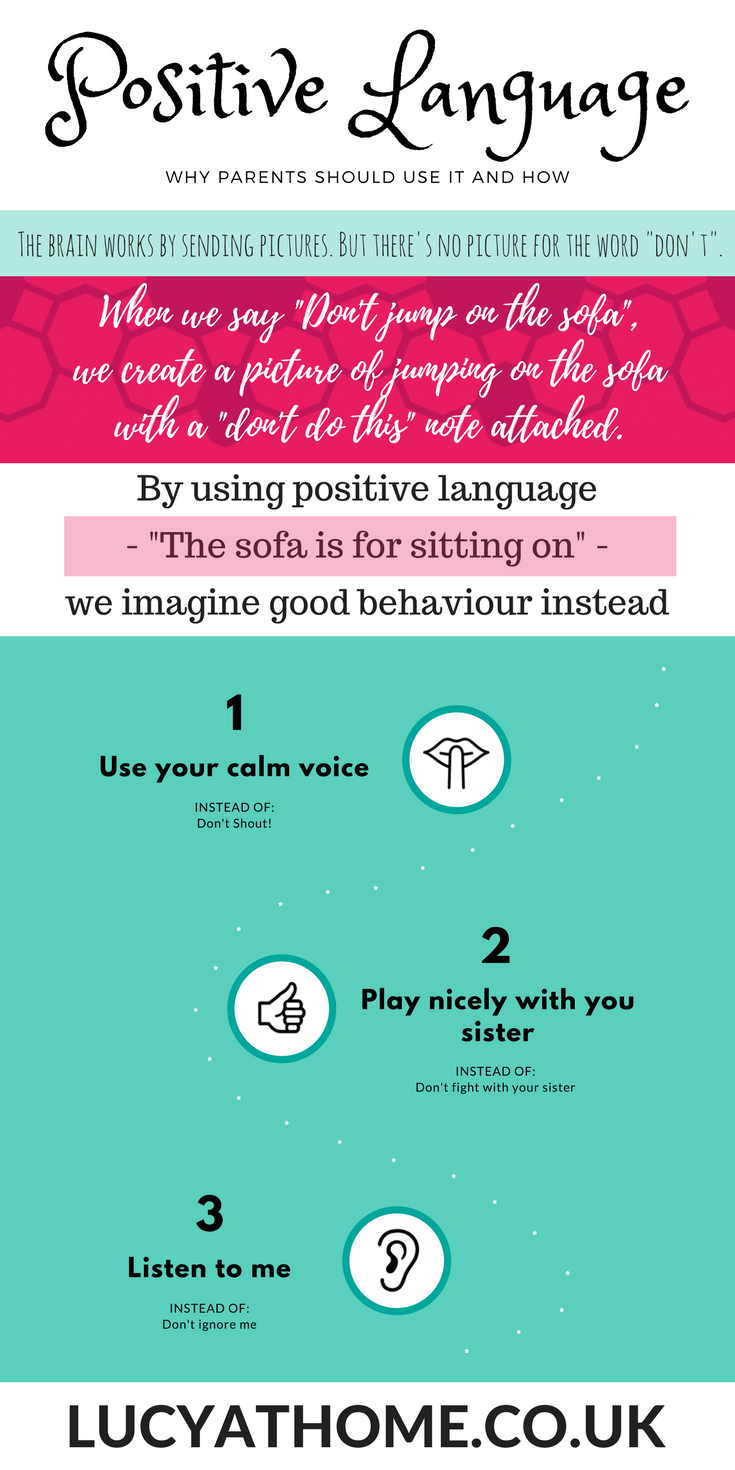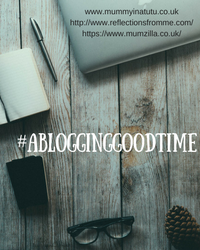
Positive Language – The Brain Theory & How To Use It
Regular readers will know that the power of words and the importance of using positive language are common themes in this blog. But today I want to tell you about why it’s important – what is the theory behind and and can it really make a difference?
I am not a psychologist or a lecturer but this idea has hugely impacted my life, and particularly my life as a parent. In fact, I’d say it’s a game-changer! I hope you find it helpful too 🙂
I’ll be covering:
- How the brain works
- How positive language ties into this
- Examples of positive language in action
How the brain works
Pictures
The brain is an amazing bit of kit! It can whisk us off to a white, sandy beach while we’re sat on the bus, or drop us off at our favourite music concert while we’re doing the supermarket shop. And a lot of our brain’s conscious work is communicated to us with pictures – memories, ideas, daydreams and designs all come to us as fleeting images, flickering across our minds’ eye.

But have you ever noticed that there’s no picture for the word “don’t”?
If I say to you “Don’t look at your hands” – did your brain just send you a picture of you continuing to read this blog, or did it imagine you looking at your hands?
Yup – it imagined your hands, didn’t it!
Okay, now you’ve seen it in action, let’s try another one, and remember to look out for what picture your brain creates…
“Don’t put your coat on.”
What was the image this time? Was it a picture of you continuing to sit where you are, or did you picture yourself slipping your arms into your coat?
That’s because there is no picture for the word “don’t”. Our brain just has to send a picture of us doing something with a note attached that says “you’re not allowed to do this”.
But the problem is, you’ve already pictured yourself doing that thing…
Point One: There is no picture for the word “don’t”
Neuroplasticity
Next let’s have a super quick talk about the way the brain learns. My fellow blogger, Hayley from Mission: Mindfulness explains the idea of Neuroplasticity with this simple analogy:
Have you ever gone for a walk across a field where no one else appears to have trodden before? You know this to be true because the grass is lush and springs back into place easily after you’ve walked on it.
And then you begin to tread that path everyday. After a few days the grass stays flat when you walk on it. Then it becomes a little patchy with brown, dusty sections coming through. Then the grass has disappeared altogether and a footpath has emerged. Others begin to use it and it broadens and becomes more apparent – easier to use.

This is similar to how the brain works. When a thought (a memory, an idea, a feeling) occurs to you for the first time, it creates a pathway in the brain. If that thought (or pathway) is used regularly, it will become clearer and easier to access. Gradually more thoughts (pathways) will connect to it like side roads leading to a main street.
So your first thought about painting the living room blue gradually becomes easier to visualise, and your brain starts thinking of matching cushions and pictures, and when you see blue rooms elsewhere you imagine your own room being blue at home, etc
Point Two: Thought pathways that are used regularly become easier to access
Positive Language: Why It’s Important
I hope you’re still with me because the important life-changing parenting bit is coming up in the next paragraph!
So we’ve learnt that the brain transmits pictures to us but there’s no word for don’t. We’ve also seen that the thought pathways we use a lot are easier to access.
That means, when you tell your child NOT to jump on the sofa… you are ENCOURAGING them to jump on the sofa!

Here’s why:
- You say: “Don’t jump on the sofa”
- Their brain pictures them jumping on the sofa
- The more often you say it, the more they picture themselves jumping on the sofa
- The more they picture it, the easier it is to access that idea
- The more they jump on the sofa
Uh oh!
But fear not! All it takes is an adjustment in the language you use. By swapping negative language ( “don’t” ) for positive language ( “do” ), you will find your guidance much more effective.
So instead of saying “Don’t jump on the sofa”, you say “The sofa is for sitting on”. Now the child is imagining sitting on the sofa – the power of positive language!
Examples of Positive Language in action
I’ve put together a little list of Positive Language examples to help you see idea more clearly. It takes a while to get into this way of thinking as your first thought is often to say “DON’T do xyz”, but it soon becomes second nature, and it really can make a massive difference.
| Instead of saying this… | Try this… |
| Don’t jump on the sofa | The sofa is for sitting on |
| Don’t shout at me | Use your calm voice |
| Stop fighting with your sister | Play kindly with your sister |
| Don’t ignore me | Listen to me |
| Don’t let your shirt get dirty | Keep your shirt clean |
| You can’t go to Grandma’s house tonight | We need to go home tonight |
I hope you found that helpful. I know it has made a huge difference to the behaviour in our house. But it’s also made for a happier environment because I’m not saying “don’t do that” all the time – using positive language feels kinder and more optimistic.
Is this an idea that you have come across before? Is it something you would consider trying? Do you think much about the power of words or is this a new idea? Let me know in the comments section below – I love your feedback.
Pin it:

Linked to:




I love this, admittedly I use “don’t,” far too much but we do try and monitor our negative language. We have primarily used it from a life outlook point of view rather than discipline but I’ll give it a go in that way now. I hate it when I hear myself saying things like “well the problem is….” it just sounds so negative and gloomy.
I’m a big believer in the importance of positive language towards our kids, great post for explaining it. Really enjoyed reading. #blogcrush
How interesting. I’ve sat her and realised that I never use the word ‘don’t’ with my kids, just like I don’t use ‘can’t’ and I’ve not really thought about it before. I do consider myself a very positive thinking person so maybe positive language just comes naturally to me.
#blogcrush
So interesting – that idea of ‘don’t’ being reframed as a word is clever, will be sharing on Facebook too to reread. I recently read another article about using the word ‘happy’ in the moment you feel it, positive words have an enormous impact. #BlogCrush
I love this! I’ve been trying to work with my husband on switching his language with our one year old who is a sponge. Saying “no hitting” twenty times in a a row is not going to do any good. Definitely sharing this with him! Thank you for sharing! #BlogCrush
ooh this is interesting. I think I will have to make a concerted effort though as “don’t” seems to trip off the tongue too easily. #blogcrush
Love this post Lucy! I’m starting with ‘Use your calm voice’ this instant:)
#Blogcrush
This is such a useful post Lucy – especially your point about the word ‘don’t’ – that really is a game-changer! Thanks for including a reference to my blog too 🙂 xx
I am right in the middle of writing a similar post!! Now I can’t pretend not to have read yours>..doh. Haha
This is what teachers do all the time….it’s the ‘LETS WALK TO GET OUR COATS!” or ‘ LETS KEEP THE SAND IN THE TRAY’ it really, really works as the children can’t really fail at it. Like you say, if you say, “why is the sand all over the floor?” Children will hear sand on the floor and out more on the floor! Interestingly, very young children or children with special needs may only hear and process the last part of a sentence too such as, “stop throwing your toys….” yeap, they will throw their toys. Lovely post and I may have to change mine a little now! Xxx #blogcrush
I love this post. so simple and obvious once its pointed out . #blogcrush
I have a child who struggles to process language and I do have to keep focussing on the language I use. After a tough evening, I think I needed this reminder. #BlogCrush
Wow! I learnt so much from this. I’ve recently started using ‘no’ and ‘dont’ my 11 month old understands the terms but I’d rather adopt the positive language approach. Thanks for sharing x
#BlogCrush
Soffy // themumaffairs.blogspot.com
This is an excellent explanation Lucy! We try to use positive language as much as possible – both with Dee and in life in general. Saying something you don’t want to happen always puts the idea of the possibility that it might happen into the universe and the more negative things we can prevent from being put out there the better! #BlogCrush
This is really interesting because I do have a sofa jumper! The more I say ‘don’t’, the more hilarious he thinks it is! I’m going to try this tomorrow!
#BlogCrush
I knew these things from before, but I’ve never heard seen them explained as well as this! Short enough to be a quick read, but straight to the point so all you need to know is there. Brilliant! x
Got so excited I forgot to add the hashtag… #blogcrush ☺️
I’ve come across this before but LOVE the way you have put it. My eldest loves to bounce on the sofa and my bed! It takes practice in using alternative language but we will get there. I also find myself explaining why they shouldn’t do something even if I’m the only one who truly understands. #BlogCrush
I think most if not all parents including myself could do well to read this every day. I find giving the children choices helps a lot with behaviour too. #BlogCrush
I LOVE this and it’s so helpful. It really help me not use the “don’t” word. #ablogginggoodtime
I have read a few things about positive parenting lately, but this is the time I come across the power of positive language. Thank you so much for this! I’m going to share this with my husband, and start practicing right away!
#ablogginggoodtime
Back with #ablogginggoodtime. Xxx
I am a big advocate for positive language, with the children and with myself! #SharingTheBlogLove
Positive language does make such a difference. I’ve read before about how the word “don’t” makes you think about doing the thing you’ve been told not to do and so I try not to use it (although I often forget and then use it again!) I like the analogy for neuroplasticity – that’s a good way of thinking about it. I have to admit I do notice the difference when I use positive language rather than negative language – my girls always respond much better to it. Interesting to read the science behind it. #sharingthebloglove
I absolutely believe in the power of positive language – I’ve used it a lot with my own inner voice to boost my self esteem and confidence. But for some reason this has been a great reminder for me as I’d not considered the impact of the negative words towards my son – I’m always telling him not to do things at the moment! It makes perfect sense, and I’m going to try hard to change my language. Thanks for joining us at #SharingtheBlogLove
The power of words is incredible. Not just for the person saying them, but also the person hearing them. I’m really conscious with my girls, especially my eldest the impact of what I’m saying and the words I’m using. Thank you for joining us at #SharingtheBlogLove
[…] into a behavioural rut when you’re a parent, and I realised in reading Lucy’s post, Positive Language – The Brain Theory and How to Use It, that I’m guilty of using a lot of negative language with Max. It’s so easy when you […]
It’s so hard to find the right words sometimes but it’s so important. Thank you for the timely reminder. (Now, will this work on a teenager I wonder?!)
Hi, I loved this it’s time for me to start using that calm voice #sharingthebloglove
This is such a great post. I find myself slipping into using ‘don’t’ far too much so definitely going to look st reframing it. #sharingthebloglove
Love this. The power of words is incredible. I really need to think more about what say before I say it. #sharingthebloglove
This is a great post and I love the alternatives you are offering for some negative phrases! I need to put these into practice! Thank you for sharing. #sharingthebloglove
You’re so right! I find when hanging with negative people, I become much more so. #BlogCrush
Remember this post well … and have even quoted from it. !!#BlogCrush
Positive language really works with my child. I’ve noticed that my son responds better when I tell him what to do instead of what not to do. Thanks for the pinnable photo. Pinned! #BlogCrush
Oh this is amazing!! Now to put this into practice with my husband haha… xx
Lucy, don’t know how I missed this one before, but I’m glad I saw it on #BlogCrush today! This is brilliant! Pinning, tweeting AND emailing to friends. (I’m not participating in BlogCrush now because of the new inlinkz requiring login, but will continue to visit.)
OMG! This makes so much sense, and is so obvious really. We are told to do it ourselves when we are trying to stop our own negative behaviours. Great post as ever. #BlogCrush
I’ve heard of this before but never really understood the reasoning before, great explaination, I will try to put it into practice!
I love this post! I hate negative comments. I feel rubbish for using them again and again and as you say they really don’t work! I love the logic behind this. I’m definitely going to give it a try. Thank you. #BlogCrush
crikey! I’ve been working on affirmations and visualisations for a few weeks now and haven’t seemed to make waves with it… these three points have unlocked the part of my brain that I needed to process this in a way I can visualise it…thank you, I can move forward now xx
Brilliant post as always!! The mind is such a clever thing! I think I often maybe use negative language without even realising it . Must think before i speak !! #blogcrush
Love this post Lucy! It’s so well explained and all makes perfect sense when you put it all as simply as this. I will definitely be using more positive language from now on xx
What a fab post.
I use this positive method with the children I work with. Then praise them for listening/follow instructions. It really makes a world of difference.
Your visual explanation’s are brilliant. Plus the examples are a fab way of seeing how to adjust your language.
I’ll definitely share your post with my colleagues that struggle with using a positive alternatives for unwanted behaviour.
Thanks for sharing!